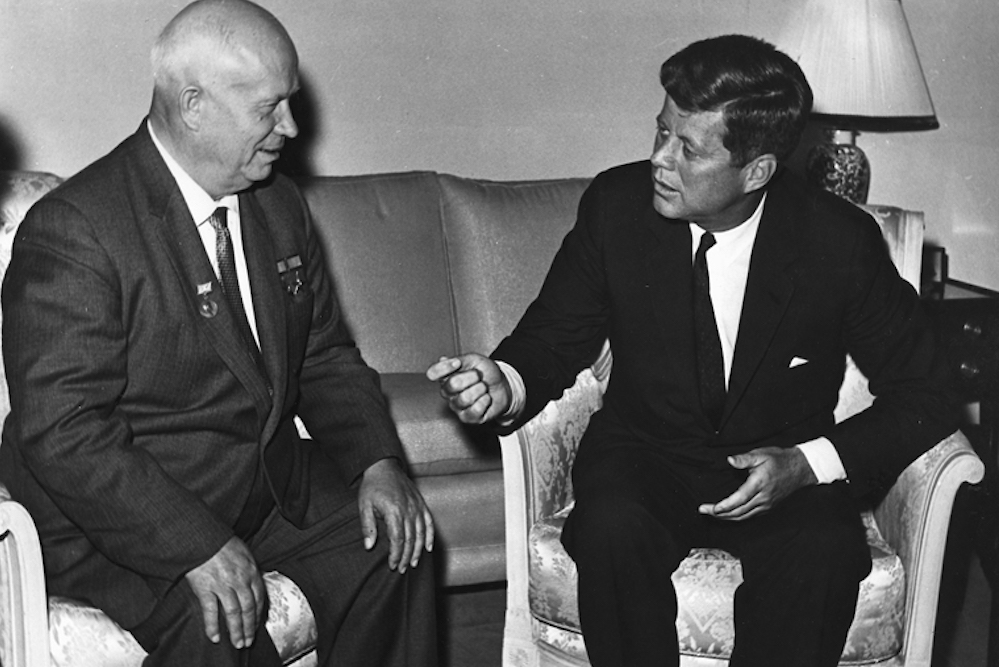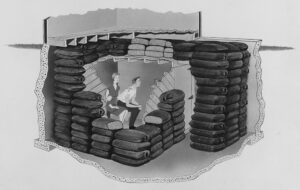
John F. Kennedy and Soviet leader Nikita Khrushchev, in 1961. As Kennedy began his presidency, nuclear tensions between the superpowers were on the rise. Courtesy of the U.S. Department of State/John F. Kennedy Presidential Library and Museum, Boston.
President Trump’s speech before the Republican National Convention (RNC) will provide an interesting coda to a year marred by White House communication blunders. In March, as COVID-19 took over newsfeeds and threatened hospitals and households, an average of 8.5 million people seeking guidance—“roughly the viewership of the season finale of The Bachelor, according to the New York Times—tuned in to President Trump’s then-daily coronavirus television briefings. But by June, the president had threatened military action against protesters and had posed in front of St. John’s Episcopal church clutching a bible for an ill-informed photo op. In television interviews in July and August, he seemed to struggle to understand his own administration’s virus response.
Throughout the pandemic, public commentators have been quick to draw historical analogies between Trump’s performance and past White House communications. The president’s televised briefings have been compared, often unfavorably, to Abraham Lincoln’s carefully crafted public addresses, or to Franklin D. Roosevelt’s Fireside Chats. “D.J.T. is No F.D.R.,” one columnist opined.
The promise of “nightly surprises” for the RNC convention has, once again, encouraged political pundits to fixate on the rhetorical work Trump has before him. But while seeking sense and stability from the nation’s historic statesmen is only natural, the drive to find positive examples from the past distracts as much as it illuminates. Sometimes, presidential silence is most constructive for leading citizens through a crisis.
A case in point is a speech that President Kennedy considered delivering on civil defense. Drafted at the height of the Cold War but never presented to the public, this “fireside chat” would have explained what would happen if the Soviet Union launched a surprise attack against the U.S., with the goal of rousing Americans to build their own personal shelters against attack. The story behind Kennedy’s decision to remain silent reveals the enduring limits of presidential communication.
John F. Kennedy’s time as president coincided with a period of international relations often referred to as the nuclear crisis. Bookended by the surprise launch of the Soviet satellite Sputnik in 1957 and the Cuban Missile Crisis and signing of the Partial Test Ban Treaty in 1962 and 1963, the nuclear crisis was the true high point of the Cold War. When Kennedy entered the Oval Office in 1961, the Kremlin and the Pentagon were engaged in multiple covert operations against each other. Spy networks hunted out military secrets, and cultural warfare was conducted through various media. The two nations also backed proxy conflicts across the globe from Cuba to the Congo.

An artist’s rendition of a basement fallout shelter, from the mid 1950s. As the threat of nuclear war began to feel real to Americans, many built protective home hideouts. Courtesy of the National Archives at College Park/Wikimedia Commons.
Nuclear weapons were at the heart of the Kennedy-era Cold War. Military strategists and think tank intellectuals—the people parodied and immortalized in Stanley Kubrick’s Dr. Strangelove—saw the proliferation of nuclear warheads as the best way to deter the Kremlin. These “wizards of Armageddon,” as journalist Fred Kaplan branded them, based their judgment on cold, mathematical calculations, and game-theory models of decision making with the aim to predict strategic interactions between the Cold War superpowers. This work led them to embrace a paradox: that more nuclear weapons could create stability; neither side, they argued, would risk attack because of the certainty of an equally violent response.
Mutual assured destruction (unironically referred to as “MAD”) had a tangible impact on U.S. military spending. By 1960, the United States nuclear stockpile consisted of 18,638 missiles, enough to destroy the world many times over. But nuclear war is equal parts foreign and domestic policy—and in 1961, Kennedy’s first year in office, managing public anxiety over nuclear weapons became a major political headache for the administration.
A series of high-profile international incidents turned the topic of Armageddon into water cooler conversation. April brought the public revelation of CIA misadventures in the Bay of Pigs, where 1,400 Cuban exiles launched a botched invasion of Cuba’s south coast in an effort to depose Fidel Castro. In June, during a conference in Vienna, Kennedy engaged in a tense exchange with Soviet Premier Nikita Khrushchev over a continuing border dispute in divided Berlin, where a steady stream of emigrants fled East Germany for the West. Refusing to engage Khrushchev in an ideological debate or to guarantee citizenship status for fleeing East Germans made Kennedy appear nervous before the international press. Newspapers on both sides of the Iron Curtain ran stories about a young president “outmatched” and “underprepared”.
On July 25, 1961, Kennedy, still stinging from media coverage of his performance in Vienna, replied to critics at home and abroad in a televised public address in which he implied the U.S. might be willing to risk nuclear war over Germany’s fate and increasing Communist aggression. Staring directly into the camera, under the harsh glare of klieg lights, Kennedy told an audience of 25 million Americans that nuclear war was a real possibility—and that they needed to prepare.
The country had a “sober responsibility to recognize the possibilities of nuclear war in the missile age,” the president said, adding that neglecting to show Americans “what they should do and where they should go if bombs begin to fall, would be a failure of responsibility.” If a nuclear bomb fell on American soil, he suggested, families who were not killed in the initial blast or fires could be saved “if they are warned to take shelter and that shelter is available.” Kennedy affirmed his personal investment in helping the nation-in-crisis, promising “to let every citizen know what steps he can take without delay to protect his family in case of an attack.”
The speech, designed to wake listeners and call them to constructive action, was a disaster: Instead of banding purposefully together, Americans panicked. Previously, the public had been aware of the threat of nuclear attacks and the existence of civil defense—thanks to Federal Civil Defense Administration’s public education campaigns, featuring Bert the Turtle cartoons and duck and cover drills in schools—but apathetic about the practical ramifications of surviving them.
Yet after Kennedy’s speech, they obsessed over building protective shelters. Newspaper reports from the time described anxious families hounding officials at the Office of Civil Defense for information on converting houses, gardens and basements into nuclear bunkers.
The news kept raising new alarms. In August 1961, construction of the Berlin Wall began. A month later, the Soviet Union detonated a 16-kiloton bomb—codenamed “Joe 75”—at the Semipalatinsk test site in Kazakhstan, breaking an international moratorium on nuclear testing that had been in place for nearly three years. Over the next 16 months, the United States and Soviet Union conducted more nuclear tests than they had in the 16 preceding years. Global radiation levels spiked. The Cold War heated up. And thermonuclear war was becoming a real possibility.
While the total number of shelter assembly kits sold between 1961 and 1962 remained relatively low (Consumer Reports estimated around 200,000 were sold), the topic of shelters and survival became an editorial goldmine. LIFE magazine dedicated its September 1961 issue to the “fallout shelter question.” Public intellectuals from Margaret Mead to I.F. Stone produced stunning editorials on the damage privatized survival might have on the national character. TIME reported that some people openly threatened to shoot outsiders who tried to access their private shelter spaces—a strategy the magazine called “gun thy neighbor.”
After the July 1961 address, the Kennedy administration, realizing its misstep, started drafting a new presidential speech and preparing a new civil defense pamphlet, tentatively titled “Fallout Protection and You,” to deliver to every household in the United States. Modeled directly on Roosevelt’s successful Fireside Chats, Kennedy’s new address was intended to right the wrongs of the July message, providing a series of practical steps every household could easily take over the next few months. From September to late December, the administration worked tirelessly on the speech and pamphlet, a blueprint for the nation’s survival.
The task proved far more difficult than anticipated. The writers were dealing with tough content. “One conclusion is that any major nuclear attack on this country would kill tens of millions of people,” one proposed version of Kennedy’s speech stated plainly, adding:
There is no practicable program which would avert incredible destruction, slaughter, horror and chaos. The only way by which we could protect ourselves from the direct of blast, heat and firestorm is by burying our cities deep underground. We could carry out such a program only to the exclusion of nearly everything else in our national life—a course of action which makes no sense to me.
The proposed speech also made direct reference to the potential violence surrounding access to private shelters, with a warning given that “superpatriots” stockpiling private shelters should not “tyrannize their fellow citizens.”
Reading the various drafts, it is striking how honestly the issue of nuclear annihilation was addressed. White House staffers—wrestling with how to ask regular citizens to mount a civil defense with cinder blocks and concrete when there was no practical way for the federal government to do so—began to wonder if the whole exercise was entirely absurd. Some began to refer to the booklet as the “Fallout Is Good for You” guide. Fred Dutton, special assistant to the president, wrote in a memo that “the feel of the pamphlet, especially the drawings, is not reassuring. I suspect a poor public reaction to this.”
Dutton’s response was the mildest among Kennedy’s advisors. Senior White House advisor John Kenneth Galbraith criticized the Department of Defense for allowing some ridiculous ideas into early drafts of the message, including a bizarre reference to a wooden fallout shelter modeled after a frontier log cabin. Chiding the Pentagon in a memo prefaced, “I regard this as a matter of high importance,” Galbraith expressed concern about the political cast of the messaging. Privatized survival was a strategy designed for “saving Republicans and sacrificing Democrats … There are survival plans for people who have individual houses with basements in which lean-to fallout shelters can be built” but “no design for civilians who live in congested areas, tenements, low cost apartments.” The address in its current form, he continued, “seeks to save the better elements of the population, but in the main writes off those who voted for you.” Galbraith found the prospect of a presidential address on the matter “absolutely incredible and particularly injudicious.”
Ultimately, Kennedy’s advisors determined that the best solution, in the words of top aide and speechwriter Theodore Sorensen, was to allow the issue to “balloon” away—to “resist” Kennedy’s “natural urge to address the nation.” It would be better to leave the matter to other officials with greater knowledge, and less political profile. Spokespeople from federal agencies would still handle public inquiry, and local officials would work to identify existing public spaces that might be converted in community shelters. But direct communication from the president to the public on the question of privatized civil defense was severed.
There is much to glean from the tumultuous journey of this forgotten and abandoned speech. One crucial lesson is that the messenger matters. As public anxiety grew and the threat of nuclear warfare drew closer, Kennedy’s team came to realize that a presidential address would be unhelpful—because the public trusted experts more than elected officials when it came to their families’ survival.
In our COVID-19 pandemic, we can trace a similar response. As officials rush to reassure the public through an unceasing barrage of updates—muddling statistics and offering deeply questionable advice on using disinfectant in the body—they should consider whether their interventions, like Kennedy’s, result more in fear than faith.




Send A Letter To the Editors